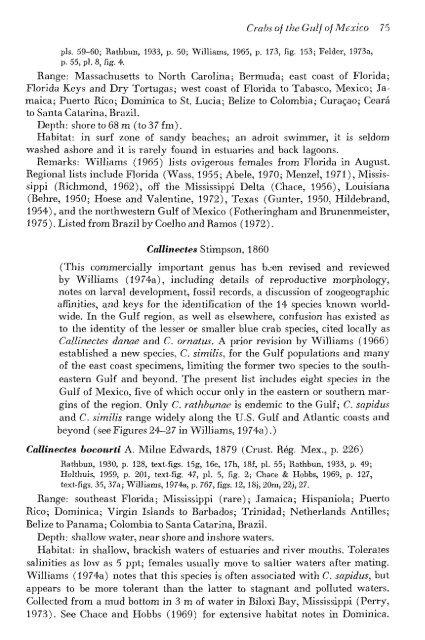You also want an ePaper? Increase the reach of your titles
YUMPU automatically turns print PDFs into web optimized ePapers that Google loves.
Crabs of ihe Gulf of Mexico 75<br />
pis. 39-60; Rathbun, 1933, p. 50; Williams, 1963, p. 173, fig. 133; Felder, 1973a,<br />
p. 55, pi. 8, fig. 4.<br />
Range: Massachusetts to North Carolina; Bermuda; east coast of Florida;<br />
Florida Keys and Tirj Tortugas; west coast of Florida to Tabasco, Mexico; Jamaica;<br />
Puerto Rico; Dominica to St. Lucia; Belize to Colombia; Curagao; Ceara<br />
to Santa Catarina, Brazil.<br />
Depth: shore to 68 m (to 37 fm).<br />
Habitat: in surf zone of sandy beaches; an adroit swimmer, it is seldom<br />
washed ashore and it is rarely found in estuaries and back lagoons.<br />
Remarks: Williams (1965) lists ovigerous females from Florida in August.<br />
Regional lists include Florida (Wass, 1955; Abele, 1970; Menzel, 1971), Mississippi<br />
(Richmond, 1962), off the Mississippi Delta (Chace, 1956), Louisiana<br />
(Behre, 1950; Hoese and Valentine, 1972), Texas (Gunter, 1950, Hildebrand,<br />
1954), and the northwestern Gulf of Mexico (Fotheringham and Brunenmeister,<br />
1975). Listed from Brazil by Coelho and Ramos (1972).<br />
Callinecles Stimpson, 1860<br />
(This commercially important genus has bL;en revised and reviewed<br />
by Williams (1974a), including details of reproductive morphology,<br />
notes on larA^al development, fossil records, a discussion of zoogeographic<br />
affinities, and keys for the identification of the 14 species known worldwide.<br />
In the Gulf region, as well as elsewhere, confusion has existed as<br />
to the identity of the lesser or smaller blue crab species, cited locally as<br />
Callinectes danae and C. ornatus. A prior revision by Williams (1966)<br />
established a new species, C. similis, for the Gulf populations and many<br />
of the east coast specimens, limiting the former two species to the southeastern<br />
Gulf and beyond. The present list includes eight species in the<br />
Gulf of Mexico, five of which occur only in the eastern or southern margins<br />
of the region. Only C. ralhhunae is endemic to the Gulf; C. sapidus<br />
and C. similis range widely along the U.S. Gulf and Atlantic coasts and<br />
beyond (see Figures 24-27 in Williams, 1974a).)<br />
Callinectes bocourti A. Milne Edwards, 1879 (Crust. Reg. Mex., p. 226)<br />
Rathbun, 1930, p. 128, text-figs. 15g, 16e, 17h, 18f, pi. 55; Rathbun, 1933, p. 49;<br />
Holthuis, 1959, p. 201, text-fig. 47, pi. 3, fig. 2; Chace & Hobbs, 1969, p. 127,<br />
text-figs. 35, 37a; Williams, 1974a, p. 767, figs. 12,18j, 20m, 22j, 27.<br />
Range: southeast Florida; Mississippi (rare); Jamaica; Hispaniola; Puerto<br />
Rico; Dominica; Virgin Islands to Barbados; Trinidad; Netherlands Antilles;<br />
Belize to Panama; Colombia to Santa Catarina, Brazil.<br />
Depth: shallow water, near shore and inshore waters.<br />
Habitat: in shallow, brackish waters of estuaries and river mouths. Tolerates<br />
salinities as low as 5 ppt; females usually move to saltier waters after mating.<br />
Williams (1974a) notes that this species is often associated with C. sapidus, but<br />
appears to be more tolerant than the latter to stagnant and polluted waters.<br />
Collected from a mud bottom in 3 m of water in Biloxi Bay, Mississippi (Perry,<br />
1973). See Chace and Hobbs (1969) for extensive habitat notes in Dominica.

















